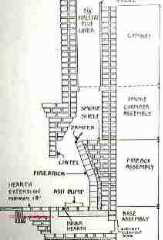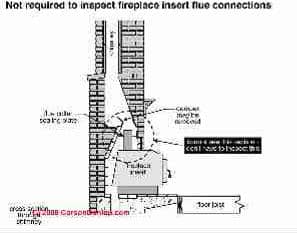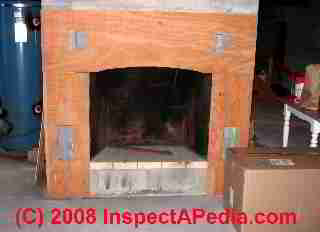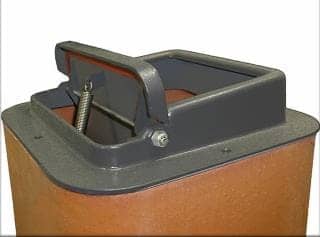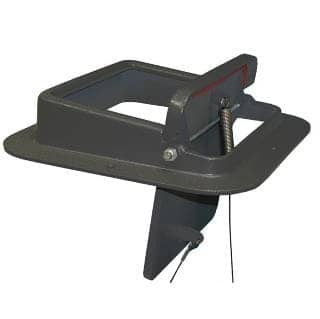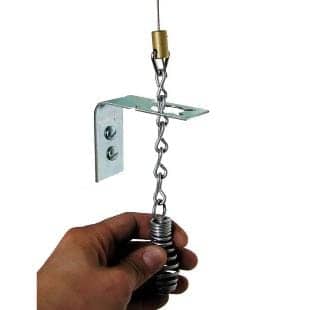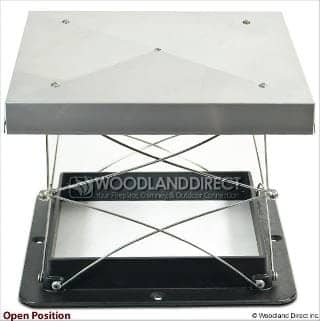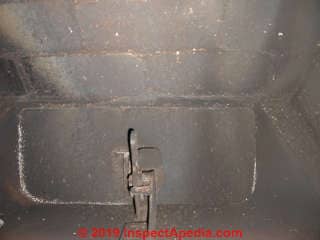 Fireplace & Chimney Dampers
Fireplace & Chimney Dampers
Fireplace damper inspection, operation, & repair
- POST a QUESTION or COMMENT about inspecting, diagnosing, & repairing fireplace damage from settlement, cracks, masonry movement
Fireplace Dampers: construction, inspection operation & repair:
What is a fireplace damper, where is it found and how should you use it? When should the damper be opened, closed, or adjusted? Fireplace dampers can rust, break, crack or collapse, leading to increased building heating costs, invasion by pests, and other trouble. Here we explain how to inspect & repair fireplace dampers.
This article series provides information about masonry fireplaces, including inspection for damage/hazards (cracks and gaps that appear at masonry fireplaces due to chimney or fireplace settlement or movement), fireplace chimney sizing requirements, draft problems, chimney safety, creosote problems, inserts, and other topics.
InspectAPedia tolerates no conflicts of interest. We have no relationship with advertisers, products, or services discussed at this website.
Fireplace Damper Trouble Inspection, Diagnosis, Repair
A fireplace damper is a metal door installed in the fireplace chimney throat. To avoid wasting building heat by sending it up the chimney when a fireplace is not in use, the fireplace damper door is closed when the fireplace is not in use.
[Click to enlarge any image]
In the sketch above you can see the position of a fireplace damper in the fireplace below the smoke shelf and labeled "damper". In this drawing the fireplace door is in the open position. Just below we show a horrible excuse for a fireplace damper: a pillow stuffed into the fireplace throat, and at below right we show a normal, closed fireplace damper door. Note that the dimensions given in this sketch are recommendations and not "building code".
Our sketch below, provided by Carson Dunlop Associates and used with permission, shows the location of a fireplace damper in the chimney flue where a woodstove or fireplace insert has also been installed.
[Click to enlarge any image]
Fireplace Damper Inspection
Inspect fireplaces for a working damper. Check that the damper door will open and close properly, that all parts are present, and that the damper is intact, that is not broken nor perforated by rust.
Where a steel insert fireplace is installed, inspect the upper portions of the fireplace at the chimney throat with great care. A rusted-out steel fireplace inset will be unsafe, wont' work properly, and will be costly to replace.
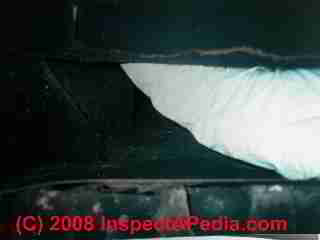
Stuffing a pillow into the chimney throat of a fireplace (above) might slow the loss of warm air from a home, but it's a dangerous substitute for a missing or broken fireplace damper. What if someone lights a fire without noticing this stuffing?
A normal cast iron fireplace damper is shown in closed position in our photo above. Closing the damper when the fireplace is not in use will make a significant reduction in heat loss from most buildings.
Our photograph just above shows a steel fireplace insert at an incomplete fireplace installation in a basement. What about that plywood "face" nailed around the steel fire chamber?
Replacement Fireplace Dampers Seal at the Chimney Top
If the damper at your masonry fireplace has been lost, rusted away, cracked or is otherwise missing or damaged beyond repair, it may be possible to install a chimney-top damper to achieve the same fireplace and draft controls you need to avoid sending building heat up the chimney unnecessarily.
A top sealing chimney damper is typically made of cast-iron and is cemented in place at the top of the chimney flue. The usually-separate chimney rain cap is also required, remains in place, and must not obstruct or interfere with operation of the damper.
Illustrated just above and in more detail below is a cast iron retrofit chimney top seal damper distributed by Woodland Direct, a fireplace and chimney and woodstove supplier. We give contact information for the company below.
A chimney-top replacement damper is typically a hinged metal door installed at the top of the chimney - working from the rooftop. A cable extends down the chimney flue and into the fireplace opening where - when the fire is not burning, the damper can be opened or closed by pulling and latching the operating cable.
Watch out: OPINION: some spring-operated chimney top dampers use a movable rain cap supported on wire arms that lift the cap up or close it down over the chimney flue. This type of cap may be suitable for gas-burning appliances, but as it omits any fire screen it may not be safe nor approved for chimney flues serving wood burning fireplaces.
For more details about regulating draft at any fuel-burning appliance, see DRAFT REGULATOR, DAMPER, BOOSTER.
Chimney Top Damper Suppliers
- Woodland Direct, 13287 West Star Drive Shelby Twp., MI 48315 USA Website: http://www.woodlanddirect.com/ Tel: 877-919-1904 (USA)
Question:
(Aug 14, 2011) Robert said:
When adding support brace under hearth should new footing be poured to support brace and weight
Reply:
Good question about hearth support, Robert.
If your floor slab is 4" or thicker, you should be OK with placing supporting columns below the hearth right onto the slab surface.
If the floor slab is thinner than 4", if it already shows signs of settlement, cracks, damage, the best repair is to cut a hole in the slab, excavate and pour a footing or pier for your columns, typically using a cardboard tube or form for the pier.
An alternative that I used in many building renovations of older homes where we needed to support an additional Lally column in a basement where the floor slab looked "OK" but was of unknown thickness, was to bed a solid 4" concrete block in concrete right onto the floor surface. The block served as a footing or pier for the column and helped spread the load out onto a wider area than otherwise had we just put the Lally column base right onto the floor itself.
Question: heatilator not working after a chimney fire
(Nov 4, 2011) Jim Jackson said:
I had a chimney fire last wintwer and immediately putit out. After that I have noticed that the heatalator that is built in does not work...do I need an inspection and is it covered under my home owners insurance?
Reply:
Jim I don't know what your homeowner's policy covers - you'll need to call your insurance company to ask. But it makes sense to have an inspection of the system for two reasons
- the chimney may be very unsafe. Frankly, after a chimney fire I would never use that chimney again without first having an expert and thorough inspection of the entire assembly
- the damage, if traced to the fire, may be covered by insurance.
Question:
(Nov 21, 2012) Dee said:
I have a glass plate hearth on top of an oak floor and under my log burning stove. It is about 18 months old now. Over the last few months the wood floor underneath the clear glass hearth has started to darken and grow mold. Now I have droplets of water under the glass and this is clearly where the mold is coming from. What can be causing this? The rest of the wooden flooring is fine, with no mold or dampness even under rugs.
Reply:
Dee
I'm not sure where it's coming from, but if you are seeing mold growth there has to be a moisture source. Are you sure it's mold?
Question:
(Feb 23, 2013) KLynne said:
Inspection of the fire box in the house I am renting revealed cracks and chips. The tech said they are small and adv I could burn occasional fires but not too much wood and no more than 2 hours. Owner will not replace fire box. I don't want to use it at all due to the cracks and chips but was researching online and saw mention of fireclay mortar that can be used to repair a fire box. Is this a practical and safe way to repair the fire box and be able to use the fireplace?
(Apr 24, 2014) Roger said:
If the firebox is elevated 12" or more off the floor do you still need a non combustible hearth extension or con the hardwood flooring be installed up to the wall that the firebox is located in?
Reply:
Roger I don't have the full picture of your installation, but a general answer is yes you need a non-combustible hearth even for an elevated fireplace. Depending on the type of fireplace and fuel, at some height the worry about radiated heat damaging the floor would of course diminish, or fall to nil. There remain spark issues.
Question: safety of shared fireplace flues?
(Jan 24, 2015) Mary Siegel said:
Have a fireplace with 2 masonry flues. One serves a first floor wood burning fireplace and the second was built to serve a lower level wood burning fireplace. Since we never used the lower level fireplace, we built an outdoor fireplace on the back side of the lower level place and used that flue to vent it.
Both the first floor and outside fireplaces work fine with this configuration. However, this year we decided to put a vent free log system in the lower level (closed off) fireplace. This fireplace had a damper with a space above it. Question: is there a way to vent our vent free logs to get rid of the gas smell. Could we install a vent that goes from the space above the damper to the outside? I believe there is plenty of depth in the masonry to fit a vent but would that work and is this safe?
Reply:
Mary
Sharing a fireplace flue is asking for trouble in draft as well as raising safety and fire spread concerns (which is why it's a code violation).
For a gas fireplace insert you'll want to provide both combustion air and venting as per the manufacturer's specs. You MIGHT be able to do that by building a direct vent to the outdoors for each purpose. I've done that using a small positive vent fan to assure no backdrafting. You'll be required to and should want to also ask for a building permit and inspections.
...
Continue reading at FIREPLACE FLUE SIZE SPECIFICATIONS or select a topic from the closely-related articles below, or see the complete ARTICLE INDEX.
Or see these
Recommended Articles
- FIREPLACES & HEARTHS - home
- BRACKET CHIMNEYS & GALLOWS BRACKETS
- CHIMNEY CLEANOUT DOORS
- CHIMNEY FIRE ACTION / PREVENTION
- CHIMNEY FLUE INSPECTION CAMERA
- CHIMNEY DRAFT & PERFORMANCE
- COMBUSTION AIR DEFECTS
- CREOSOTE DEPOSITS, FIRE HAZARD
- FIREPLACE CHIMNEY ROOF CLEARANCE
- FIREPLACE & WOODSTOVE CONTAMINANTS
- FIREPLACE DAMPER DEFECTS, REPAIRS
- FIREPLACE FLUE SIZE SPECIFICATIONS
- FIREPLACE HEARTH DIMENSIONS & SUPPORT
- FIREPLACE INSERTS INSTALL, INSPECT, REPAIR
- FIREPLACE INSPECTIONS
- FIREPLACE INSPECTION PRE-FAB
- FIREPLACE DAMAGE & UNSAFE HEARTHS
- GAS FIREPLACES & GAS LOGS - home
- GAS FIREPLACE VENT CLEARANCE REQUIREMENTS
- GAS FIREPLACE CERAMIC STAINS
- INACCESSIBLE CONNECTIONS FIREPLACE, WOODSTOVE
- RUMFORD FIREPLACE DESIGN RULES
- PYROLYSIS EXPLAINED
- WOOD BURNING FIREPLACE ROOF CLEARANCE
Suggested citation for this web page
FIREPLACE DAMPER DEFECTS, REPAIRS at InspectApedia.com - online encyclopedia of building & environmental inspection, testing, diagnosis, repair, & problem prevention advice.
Or see this
INDEX to RELATED ARTICLES: ARTICLE INDEX to CHIMNEYS & FLUES
Or use the SEARCH BOX found below to Ask a Question or Search InspectApedia
Ask a Question or Search InspectApedia
Try the search box just below, or if you prefer, post a question or comment in the Comments box below and we will respond promptly.
Search the InspectApedia website
Note: appearance of your Comment below may be delayed: if your comment contains an image, photograph, web link, or text that looks to the software as if it might be a web link, your posting will appear after it has been approved by a moderator. Apologies for the delay.
Only one image can be added per comment but you can post as many comments, and therefore images, as you like.
You will not receive a notification when a response to your question has been posted.
Please bookmark this page to make it easy for you to check back for our response.
Our Comment Box is provided by Countable Web Productions countable.ca
Citations & References
In addition to any citations in the article above, a full list is available on request.
- [4] NFPA 211 - Standards for Chimneys & Fireplaces, NFPA 211: Standard for Chimneys, Fireplaces, Vents, and Solid Fuel-Burning Appliances, 2006 Edition (older editions and standards are found at the same bookstore)
NFPA #211-3.1 1988 - Specific to chimneys, fireplaces, vents and solid fuel burning appliances. - [5] NFPA #211-3.1 1988 - Specific to chimneys, fireplaces, vents and solid fuel burning appliances.
- [6] NFPA # 54-7.1 1992 - Specific to venting of equipment with fan-assisted combustion systems.
- [6a] GAMA - Gas Appliance Manufacturers' Association has prepared venting tables for Category I draft hood equipped central furnaces as well as fan-assisted combustion system central furnaces.
- [7] National Fuel Gas Code, an American National Standard, 4th ed. 1988 (newer edition is available) Secretariats, American Gas Association (AGA), 1515 Wilson Blvd., Arlington VA22209, and National Fire Protection Association (NFPA), Batterymarch Park, Quincy MA 02269. ANSI Z223.1-1988 - NFPA 54-1988. WARNING: be sure to check clearances and other safety guidelines in the latest edition of these standards.
- [8] Fire Inspector Guidebook, A Correlation of Fire Safety Requirements Contained in the 1987 BOCA National Codes, (newer edition available), Building Officials and Code Administrators International, Inc. (BOCA), Country Club HIlls, IL 60478 312-799-2300 4th ed. Note: this document is reissued every four years. Be sure to obtain the latest edition.
- [9] Masonry Fireplace and Chimney Handbook, 2nd Ed., James E. Armhein, S.E., M.I.A. Masonry Institute of America, 22815 Frampton Ave. Torrance, CA 90501-5034 Toll free: 1-800-221-4000; the original text noted that mIA was prepared to include requirements of the 1994 UBC and other codes. Website ht.masonryinstitute.org,
- [11] NFPA 211 - Standards for Chimneys & Fireplaces, NFPA 211: Standard for Chimneys, Fireplaces, Vents, and Solid Fuel-Burning Appliances, 2006 Edition (older editions and standards are found at the same bookstore)
- New York 1984 Uniform Fire Prevention and Building Code, Article 10, Heating, Ventilating, and Air Conditioning Requirements
- "Top Ten Chimney (and related) Problems Encountered by One Chimney Sweep," Hudson Valley ASHI education seminar, 3 January 2000, contributed by Bob Hansen, ASHI
- "Chimneys and Vents," Mark J. Reinmiller, P.E., ASHI Technical Journal, Vol. 1 No. 2 July 1991 p. 34-38.
- Chimney Safety Institute of America - Chimney Fires: Causes, Effects, Evaluation
- National Chimney Sweep Guild - Yellow Pages of Suppliers
- Our recommended books about building & mechanical systems design, inspection, problem diagnosis, and repair, and about indoor environment and IAQ testing, diagnosis, and cleanup are at the InspectAPedia Bookstore. Also see our Book Reviews - InspectAPedia.
- In addition to citations & references found in this article, see the research citations given at the end of the related articles found at our suggested
CONTINUE READING or RECOMMENDED ARTICLES.
- Carson, Dunlop & Associates Ltd., 120 Carlton Street Suite 407, Toronto ON M5A 4K2. Tel: (416) 964-9415 1-800-268-7070 Email: info@carsondunlop.com. Alan Carson is a past president of ASHI, the American Society of Home Inspectors.
Thanks to Alan Carson and Bob Dunlop, for permission for InspectAPedia to use text excerpts from The HOME REFERENCE BOOK - the Encyclopedia of Homes and to use illustrations from The ILLUSTRATED HOME .
Carson Dunlop Associates provides extensive home inspection education and report writing material. In gratitude we provide links to tsome Carson Dunlop Associates products and services.


